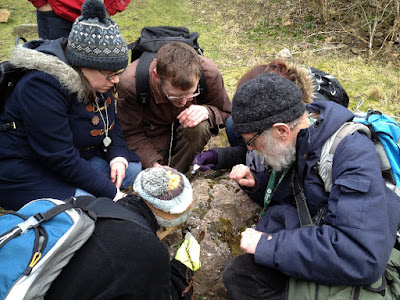1. Tortula muralis (Wall screw-moss)
2. Grimmia pulvinata (Grey-cushioned grimmia), with distinctive grey fur to catch water.
 |
| Grimmia pulvinata (Photo by Olesya) |
3. Bryum capillare (Capillary thread-moss), with bright red setae (stalks) and bright green capsules.
 |
| Bryum Capillare (Photo by Olesya) |
4. Orthotricum anomalum (Anomalous bristle-moss)
These first four wall-mosses were the only species which had stuck in my head after our previous excursion, as I'd seen them on walls all over Edinburgh. And indeed, we saw all of them on the wall of the Blackford Hill Observatory car park. They are good for beginners.
5. Didymodon rigidulus (Rigid beard-moss) is another common wall species.
6. Brachythecium rubatulum (Rough-stalked feather-moss) was the first pleurocarp moss we saw, with long, straggly, branching stems. The first four are all Acrocarp, with one capsule coming out of one upright stem.
7. Brachythecium populeum (Matted feather-moss) is an indicator of high pH, and therefore grows on the lime mortar in walls.
Moss often grows on the mortar in a wall. Wall-stones are usually quite hard and smooth, and difficult for moss to get a hold or find moisture; whereas natural rock is usually cracked and weathered and therefore covered in moss. The basalt outcrops of Blackford Hill are a good example of this.
We found the straggly pleurocarp mosses
8. Rhytidiadelphus squarrosus (Springy turf-moss) and
9. Pseudoscleropodium purum (Neat feather-moss)
both growing in the turf under a tree. Rhytidiadelphus squarrosus is a notorious nuisance in lawns and looks a bit like pipe-cleaners. Scheropodium purum needs a lot of light to flourish, and has a more juicy, succulent appearance.
 |
| Succulent Scheropodium purum (left) and bristly Rhytidiadelphus squarrosus (right) |
10. Bryum radiculosum (Wall thread-moss) is one of many mosses with an ingenious method of reproduction: it has tiny tubers or potatoes on its roots which can grow a new plant if they dry out and blow away.
11. Barbula convoluta (Lesser bird's-claw beard-moss)
12. Syntrichia ruraliformis (Sand-hill screw-moss)
13. Porella platyphylla (Wall scalewort) was our first liverwort
 |
| Porella platyphylla |
14. Amblystegium serpens (Creeping feather-moss)
 |
| Amblystegium serpens |
Then we had some examples of a varied colony of moss on a rocky basalt boulder.
15. Bryoerythrophyllum recurvirostrum (Red beard-moss) has a bright, stellate appearance and turns red when mature
 |
| Bryoerythrophyllum recurvirostrum |
16. Schistidium apocarpum (Sessile grimmia) has a smart black base and red capsules with no stalk.
17. Orthotricum rupestre (Rock bristle-moss) is stragglier than the Orthotricum anomalum we saw earlier, and has hairy capsules as if it was wearing alpaca hats, which distinguishes it from Orthotricum cupulatum which has smooth hats.
 |
| David's "apprentice" Steve demonstrating his ability to distinguish between these different types of Orthotricum. |
We then saw two more Orthotricum mosses on a nearby tree overhanging the Braid Burn,
18. Orthotricum diaphanum (White-tipped bristle-moss)
19. Orthotricum pulchellum (Elegant bristle-moss)
 |
| Orthotricum pulcellum |
The tree was also home to liverworts:
20 Metzgeria furcata (Forked veilwort) is a thallose liverwort which means it forms a flat, thin plate against the tree
21. Frullania dilatata (Dilated scalewort) looks like a brown blob on the tree, until you look closely through the lens and discover its intricate structure:
 |
| Frullania dilatata |
The next set we found in the woods of the Hermitage.
22. Pseudotaxiphyllum elegans (Elegant silk-moss) which is tolerant of both shade and higher pH
23. Isothecium mysuroides (Mouse-tail moss)
 |
| Pseudotaxiphyllum elegans and Isothecium mysuroides |
24. Polytrichastrum formosum (Black haircap) which several of us thought was a sphagnum moss (it isn't). Steve had everyone examining its toothed leaves against the light through their hand-lenses...
 |
| Polytrichastrum formosum |
 |
| Examining the toothed leaves of Polytrichastrum formosum |
25. Lepidozia reptans (Creeping fingerwort) is a liverwort with four-fingered leaves, although we all struggled to see this even through a hand-lens.
26. Pellia endiviifolia (Endive pellia - if that makes you any the wiser!), another liverwort, has little chimneys in its complex structure to regulate its own atmosphere.
27. Kindbergia praelonga (Common feather-moss), which we thought particularly attractive with its delicate and fluffy fronds
 |
| Kindbergia praelonga, like a green feather boa |
28. Dicranella heteromalla (Silky forklet-moss) is also very attractive with its dark green pincushion and bright red capsules
 |
| Dicranella heteromalla |
29. Atrichum undulatum (Common smoothcap), which has extraordinary capsules which (the hand-lenses showed us) were like pepper-pots with teeth and a drum over the top.
I don't know about everyone else but I'm hooked - and I've bought the book! It's a very well-designed field guide which leads the absolute beginner like me gently into the magical world of moss. Copies available from David.
Eleanor Harris
 |
| Fun with hand-lenses (Photos by Alex) |







No comments:
Post a Comment